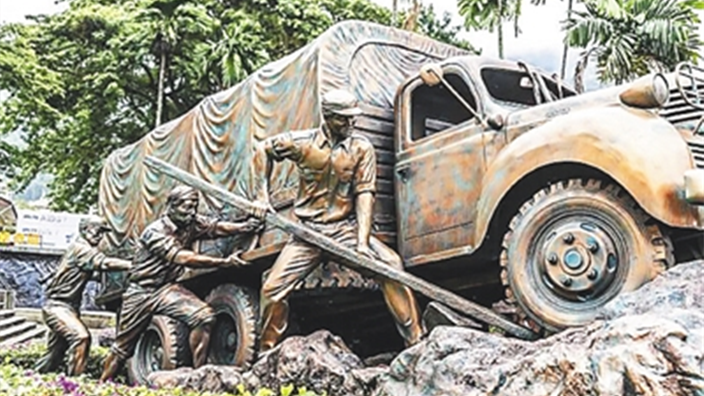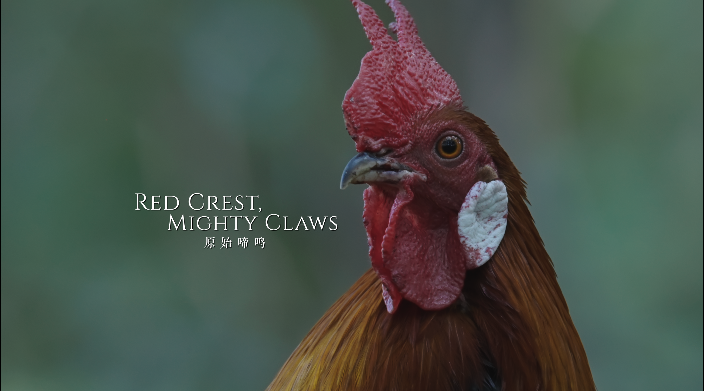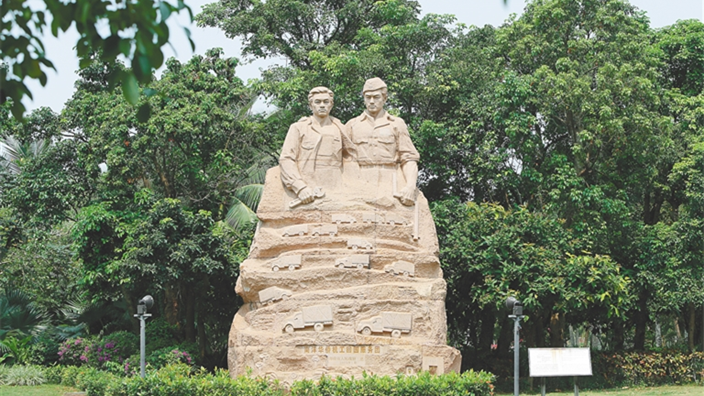By continuing to browser our site and use the services you agree to our use of cookies, Privacy Policy and Terms of Use. You can change your cookie settings through your browser.
Editor’s Note:
Over 3,200 overseas Chinese drivers and mechanics living in Southeast Asian countries were rallied by famous business pioneer and philanthropist Tan Kah Kee in 1939. From 1939 to 1942, these ‘Nanyang Volunteers’ transported 500,000 tons of military supplies and other needed items over the Yunnan-Myanmar Road (also known as Burma Road), a critical supply route, making invaluable contributions to victories in both the Chinese People’s War of Resistance Against Japanese Aggression and the World Anti-Fascist War. Over eight hundred ‘Nanyang Volunteers’ came from Hainan, and over 400 of them gave their lives on the Yunnan-Myanmar Road.
In the 1980s, Luo Jie (Luo Yuchuan), a ‘Nanyang Volunteer’ whose ancestral home was in Wenchang, Hainan, met with several friends in Haikou. After learning that the "Nanyang Overseas Chinese Jigong Anti-Japanese Monument" would be established in Kunming, Yunnan, he was moved to write a memoir, recalling the experiences he and many other overseas Chinese youths had as they decided to return to China, crossing the life-and-death line of the Yunnan-Myanmar Road as they transported supplies to support the war of resistance against Japanese aggression. The original article was published in the fourth issue of "Overseas Chinese Work Research" (《侨务工作研究》) magazine in 2023.
After the July 7th Incident (Japanese soldiers attacked Chinese forces at the Lugou Bridge - also known as Marco Polo Bridge), the Japanese mounted a large scale invasion of China in an effort to destroy the country, triggering China's full-scale resistance against the Japanese invasion. During this period, tens of millions of Chinese citizens were killed by the Japanese. In response to the call for help from the Federation of China Relief Fund helmed by Mr. Tan Kah Kee, patriotic overseas Chinese living in Southeast Asia donated money or manpower, and also mobilized volunteers to sell flowers, raising funds to be sent to China to fight the war and assist refugees.
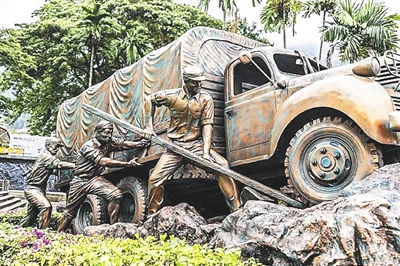
A statue of a bronze truck with the license number ‘Yunnan-Myanmar 1939’ stands in front of the Nanyang Overseas Chinese Mechanics Memorial at the foot of Penang Hill in Penang, Malaysia. (Photo: Hainan Daily)
In 1938, the Chinese People’s War of Resistance Against Japanese Aggression reached its climax. Japanese invaders continued to occupy and blockade China’s coastal ports, and relief supplies could only be brought in through Hong Kong in China and Vietnam.
In 1938, Guangzhou fell, and the city’s ports were cut off. The newly opened Yunnan-Myanmar Road became a critical supply route. At the time, there was a critical shortage of experienced drivers and mechanics in China. Mr. Tan Kah Kee, leader of the Nanyang Overseas Chinese Association, was commissioned to call upon overseas Chinese mechanics to return to China to serve their country. When patriotic overseas Chinese in different parts of Southeast Asia found out that their motherland was in urgent need of mechanics, they signed up in droves. In just a few months, over 3,000 mechanics returned to China. With a sincere passion to serve their country, they quit their jobs, abandoned their studies, and left their beloved families to return and support the war of resistance against Japanese aggression. At that time, an Overseas Hainanese man named Wang Wensong was employed as a skilled worker in a British auto repair shop in Singapore, where he earned a few hundred yuan a month. When he heard the call, he voluntarily gave up his affluent life, bringing his own repair tools and over a dozen coworkers along with him as he returned to China to face the national crisis.
In 1939, patriotic overseas Chinese workers living in different parts of Southeast Asia signed up as volunteers, and were sent to Singapore by patriotic overseas Chinese organizations. The eighth group included several hundred young workers from Guangdong, Hainan, and Fujian. They were organized into a brigade with three squadrons led by Hu Kaijun, Luo Yuchuan, and Shen Maoshan. In July, patriotic overseas Chinese in Singapore hosted a grand farewell gathering for the departing volunteers. The event was held at the Yihexuan Mansion of the Nanyang Chinese Relief Association in Tai Po, Singapore. Patriotic overseas Chinese leader Mr. Tan Kah Kee opened the meeting and instructed the attendees, raising his hands solemnly to the overseas Chinese leaders. “We are not afraid of hardship or death in the fight against Japan." The volunteers then went to the docks to board the ship, which sailed directly from Singapore for Saigon (present-day Ho Chi Minh City), Vietnam. After sailing for a few days, they arrived at the Saigon dock, where local patriotic overseas Chinese warmly welcomed them with food and accommodations. The next day, they held a farewell party before the volunteers boarded the train along with a large number of cakes provided by their hosts for the journey.
After a journey of several days, the train, which was about to arrive in Hanoi, nearly derailed in the middle of the night, causing a serious accident. The incident might have been caused by Japanese spies who pushed a large rock down the mountain onto the railway, hoping to wreck the train carrying the volunteers. Fortunately, the train carriage only sustained light damage, avoiding major casualties. The volunteers arrived safely in Hanoi, where local overseas Chinese warmly received them, provided them with food and lodging at various guild halls, and held a farewell tea party. After two more days of travel, they arrived at Kunming Station, which held a convoy of waiting trucks. The leaders of the volunteer group met with a representative of the local office, then gathered everyone together and set off by truck towards the Panjiawan Office. As soon as they entered the gates, they saw a large crowd of volunteers who had previously returned to China lined up to welcome them. After disembarking, the new arrivals were brought to dormitories to rest. The university dorms had been recently repaired after being bombed by enemy planes, and still bore the dark bloodstains of compatriots who had been killed, showing how tragic the situation truly was.
The new arrivals gathered at the training center after the flag-raising ceremony in the morning, and were assigned to the Overseas Chinese Brigade to receive military and driving training. The volunteers had military drills every morning and driving training in the afternoons. After three months of training, they took an exam, were assigned to a brigade and took on transportation duties. The volunteers passed their exams and were assigned to the 9th Brigade to transport war supplies on the Yunnan-Myanmar Road, or to repair vehicles. The 9th Brigade was sent to Mangshi to handle transportation of materials from Lashio, Myanmar to Xiaguan, Yunnan. The total distance between Lashio and Kunming is over 1,200 km., and took seven or eight days to traverse. Along the way, vehicles have to cross high mountains and steep cliffs such as the Gongguo and Dawang Mountains, and cross the Nujiang, Lancang, and Yangbi Rivers. The road is very difficult, and because it is newly built, the road surface is rugged and uneven, and becomes muddy when it rains. The slightest mistake when driving through high mountains and deep valleys can result in crashes and fatalities. The father of one of the squad leaders, Fu Qizan, was a member of the Nanyang Federation of China Relief Fund in Singapore. He had two sons. His older son had died on the front lines of the war. He encouraged his younger son, who was a teacher, to quit his job and return to China and assist in transportation work. He became the squad leader of the 13th Squadron of the Southwest Transportation Department. Soon after, Fu led a convoy from Baoshan County to transport the war supplies. When he was leaving Xiaguan and returning to Baoshan, his car overturned and squad leader Liu was killed. In order to transport materials for the war of resistance, many Nanyang Volunteers died in car crashes on the newly opened Yunnan-Myanmar Road.
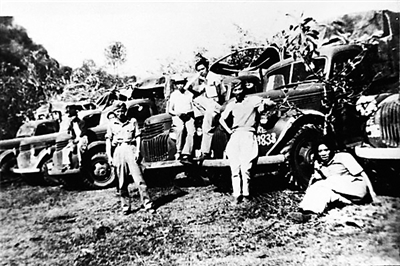
Uniformed overseas Chinese mechanics pose for a photo in front of a row of transport vehicles. (Photo: Hainan Daily)
The Overseas Chinese Pioneer Brigade is an organization composed entirely of overseas Chinese engineers and drivers, and it’s said that many of the vehicles were purchased with donations from patriotic overseas Chinese. The brigade was stationed in the Zhefang - Mangshi corridor, where diseases were rife and there was a daily risk of death from illness. When vehicles broke down, the drivers had to wait for a repair vehicle to arrive, and often had to wait, cold and hungry, in their vehicles for a couple days. The Huitong and Gongguo Bridges were bombed several times by enemy planes. Drivers had to stop without food on the road, waiting for workers to make repairs or construct ferries from oil drums. The situation was extremely difficult.
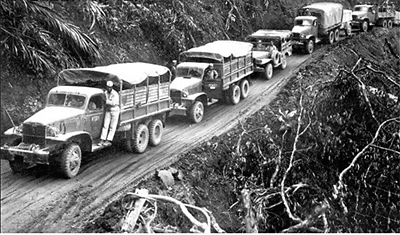
Overseas Chinese drivers pilot a convoy of trucks across the Yunnan-Myanmar Road. (Photo: Hainan Daily)
Later, Baoshan was bombed. The first time it was bombed, several vehicles in the battalion headquarters were destroyed, along with many local homes, killing or injuring a large number of people. The second time there was no alarm. Baoshan Middle School was holding a sports meeting with a large number of spectators. Suddenly, enemy planes appeared, killing or injuring hundreds of students and civilians. Large numbers of vehicles were bombed and burned, and dozens of homes collapsed. It was a horrific sight. The volunteers loudly condemned the Japanese war crimes, and also became more patriotic. They drove transport vehicles day and night without stopping, not fearing hardship or sacrifice.
Through 1941, the Japanese army moved southward and continued to occupy Malaya, Indonesia, the Philippines, and Singapore in Southeast Asia. In 1942, Myanmar (then known as Burma) fell, and the Yunnan-Myanmar Road was blocked. Many drivers and mechanics retreated to Kunming, suffering the loss of large numbers of vehicles in the Longling and Gongguo Mountains along the way. At that time, the overseas Chinese drivers who returned to Kunming from the Myanmar Road had lost their original brigade and were leaderless, suffering great difficulties. Many of them joined the Chiense Expeditionary Force, entering India for the counter attack in Myanmar. At that time, overseas Chinese Li Weimin led a group of overseas Chinese drivers to India to assist in the rush to transport war supplies from the US military airport. In August, 1945, the Japanese surrendered and the Chinese People’s War of Resistance Against Japanese Aggression was won. Many overseas Chinese were demobilized, and over a thousand returned to Southeast Asia, although some went to Yan’an or remained in southwest China. A large number of these brave fighters sacrificed their lives while transporting military supplies.
Luo Jie: Risking Death to Transport War Supplies over the Yunnan-Myanmar Road
11:22, 15-July-2025This is Hainan: Discovering Mysteries Season 5 debuts July 15
11:22, 15-July-2025Discovering Mysteries S5, E1: Red Crest, Mighty Claws
11:22, 15-July-2025Embracing Zheng He’s Spirit as Gift of Harmony Project Launched
08:19, 13-July-2025Wu Huimin: A Nanyang Volunteer who gave up his name for his country
08:19, 13-July-2025Hainan Sees Huge Surge in Intl. Travel in First Half of 2025
08:19, 13-July-2025By continuing to browser our site and use the services you agree to our use of cookies, Privacy Policy and Terms of Use. You can change your cookie settings through your browser.
